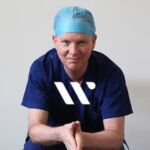
The humble neck is almost always involved in facelift procedures and it’s often the patient’s greatest concern. Here’s how we decide what to do with the neck when we’re planning a facelift.
Of all the head and neck aesthetic regions, it is the easiest to assess. Consistent improvement is achievable through fairly straightforward and safe surgery. It’s also a surgery that can make a big difference to your appearance.
When assessing the neck, you must first think of the ideal neck and then design the operation to try to get the neck shape as close to this as possible. Actually, this is not that difficult with necks. It’s probably the one area of the face where everyone agrees on what looks good or bad, regardless of personal opinion, race, or individual aesthetic.
The first important part of the assessment is to consider how well the neck will complement the appearance of the face as a whole and whether the procedure will achieve a natural-looking result.
What is a good neck, you may ask? Well, it’s shaped like a cylinder and at the top it meets a flat jawline, with a nice flat plane underneath it. The jawline should be smooth and straight and there should be a little bulge at the angle of the jaw, with a little hollow behind it. There should also be a little hollow underneath the angle of the jaw, with the tissue curving up from here in a concave shape towards the ear. When the ideal neck is flexed, the skin doesn’t bunch or become a double chin. Instead, it folds over like a hinge and there are no noticeable bands or lumps in it.
Because of individual anatomy, it is not possible to achieve this shape in all people of all ages. However, for many people it is, and this is always the starting point for an individual neck assessment.
To give you an idea of how we might operate on the neck to achieve this sort of shape, let’s start with the jawline and work our way down. For the jawline, if someone has a really small jaw or a retruded jaw, we can lengthen it using maxillofacial techniques (techniques relating to the jaws and face). We may slide the jaw forward and make it longer if there’s an overbite. Or if the dental bite is OK, we might augment the chin point with a chin implant or a bony chin advancement, as a starting point. This is because when a person has a really undershot or small jaw, the bony anatomy doesn’t lend itself to a good neck shape. Personally, I do not do the jaw advancement procedure – I will refer to other surgeons for that if I think it is needed. But I do a lot of chin augmentation, where the jaw doesn’t need surgery but the chin needs to be stronger.
If the jaw is an appropriate length, we look underneath the jaw, where we frequently see fat, wrinkles, loose skin, bands and lumps. Often the reason for a noticeable lump may be the submandibular salivary gland. This is a gland that sits just under the jawline about halfway along the side of the jaw and can become droopy with age, causing a visible lump. We may also see skin dents, folds, and horizontal wrinkles which represent where the skin attaches to the deeper tissues. When the neck flexes, we might see bunching of the skin in the shape of a double chin. And when we view the neck in profile, there’s often a noticeable loss of the deep connection of the skin to the deeper structures of the face. This is what’s commonly known as the ‘turkey neck’.
As we move to the mid-level of the neck we’re really looking at the amount of fat (there are thin and fat necks). At the same time, we assess whether the skin is firm or loose and if it’s loose, how much skin there is. Then with the lower neck, we again look at the amount of skin and the texture of it.
As you can see, though it’s not an especially complex surgery, there is quite a lot to consider when you’re planning a necklift.
Thanks for reading!
Why not head over to realself and take a look at my profile.





